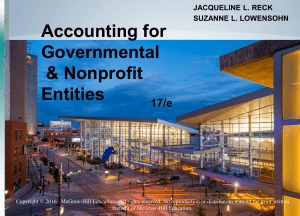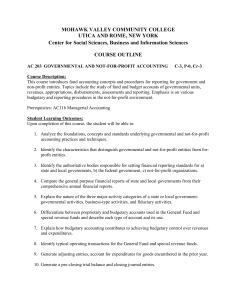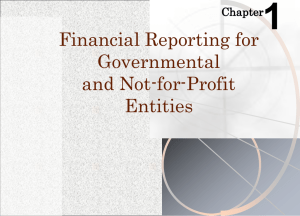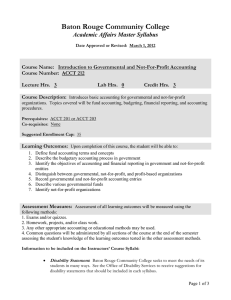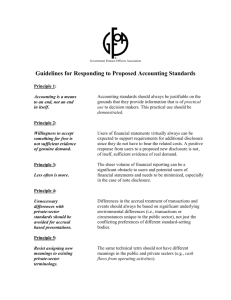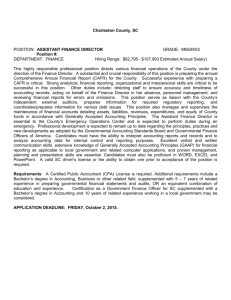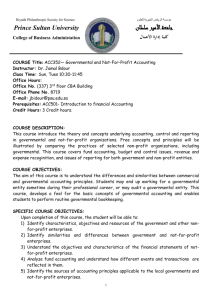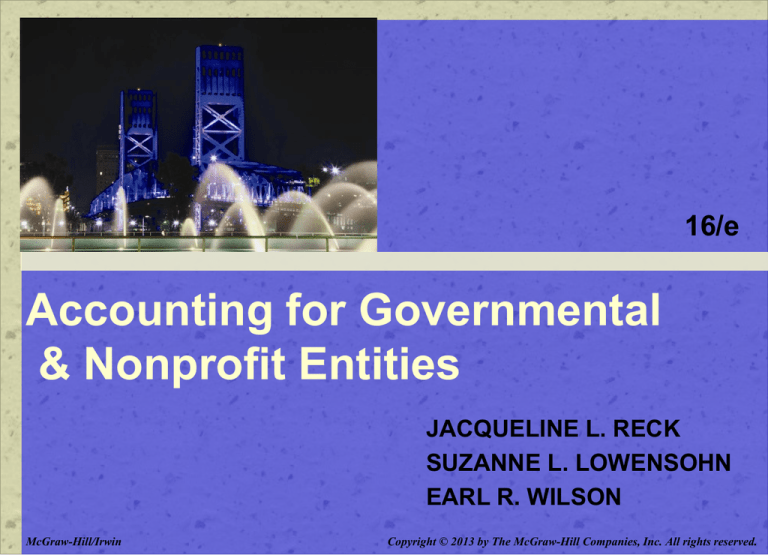
16/e
Accounting for Governmental
& Nonprofit Entities
JACQUELINE L. RECK
SUZANNE L. LOWENSOHN
EARL R. WILSON
McGraw-Hill/Irwin
Copyright ©
1-1
1-1
2013 by The McGraw-Hill Companies, Inc. All rights reserved.
Chapter
1
Introduction to Accounting and
Financial Reporting for Governmental
and Not-for-Profit Entities
Learning Objectives
After studying Chapter 1, you should be able to:
Identify and explain the characteristics that distinguish
governmental and not-for-profit entities from forprofit entities
Identify the authoritative bodies responsible for
setting GAAP and financial reporting standards for all
governmental and not-for-profit organizations
Contrast and compare the objectives of financial
reporting for state and local governments, the federal
government, and not-for-profit organizations
1-3
Learning Objectives (Cont’d)
Explain the minimum requirements for general
purpose external financial reporting of state and local
governments and how they relate to comprehensive
annual financial reports
Explain and identify the required financial statements
for state and local governments, the federal
government, and not-for-profit organizations
1-4
Welcome to Accounting for Governmental
and Not-for-Profit Organizations
Welcome
to the strange new world of accounting and
financial reporting for governmental and not-for-profit
(NFP) organizations
Why are accounting practices for these organizations
very different from those of business organizations?
Different purposes in society
Financed by resource providers who do not expect
benefits proportional to the resources they provide
Management has a special duty to be accountable for
how resources are used in providing services
1-5
What are Governmental Organizations?
General
purpose governments
Provide a broad array of services
Examples: Federal government, state governments,
cities, towns, townships, villages, counties, boroughs,
and parishes
Special
purpose governments
Usually provide only a single or just a few services
Examples: Independent school systems, public colleges
and universities, public hospitals, fire protection districts,
sewer districts, transportation authorities, and many
others
1-6
What are Not-for-Profit Organizations?
Legally
separate organizations
Usually exempt from federal, state, and local taxation
Religious, community service, private educational and
health care, museums, and fraternal
and social organizations,
among many other kinds of
organizations
1-7
How Do Governmental and Not-For-Profit
Organizations Differ from Business
Organizations?
Resource
providers do not expect to
receive proportional benefits
Lack of a profit motive
Absence of transferable
ownership rights
1-8
How Do Governmental Entities Differ
From Not-For-Profit Organizations?
Power
ultimately rests in the hands of the people
People delegate power to public officials through the
election process
Empowered by and accountable to a higher level
government
Taxation powers
1-9
Sources of GAAP and
Financial Reporting Standards
FASB
Business organizations
Nongovernmental not-for-profits
GASB
State and local governmental organizations
Governmental not-for-profits
FASAB
Federal government and its agencies and
departments
1-10
Why Governmental Financial Reporting Must
Differ from Business Financial Reporting?
Different financial report users with different
needs
Governmental financial reporting focuses on
stewardship and accountability for how public
resources are raised and used to provide
services
1-11
Objectives of Financial Reporting—State
and Local Governments (SLG)
Governmental financial reports are used primarily to:
Compare actual financial results with legally
adopted budget
Assess financial condition and results of
operations
Assist in determining compliance with financerelated laws, rules, and regulations
Assist in evaluating efficiency and effectiveness
1-12
Objectives of Financial Reporting—
SLG (Cont’d)
“ACCOUNTABILITY is the cornerstone of all
financial reporting in government “ (GASB
Concepts Statement No. 1, par. 56)
1-13
Objectives of Financial Reporting—
SLG (Cont’d)
Q: What do we mean by accountability?
A: Accountability arises from citizens’ “right to
know” It imposes a duty on public officials to
be accountable to citizens for raising public
monies and how they are spent
1-14
Objectives of Financial Reporting—SLG
(Cont’d)
Q: How does “interperiod equity” relate to
accountability?
A: Interperiod equity is a government’s obligation to
disclose whether current-year revenues were
sufficient to pay for current-year benefits—or did
current citizens defer payments to future
taxpayers?
1-15
Objectives of Financial Reporting—
Federal Government
Accountability is also the foundation of federal
government financial reporting
Federal Accounting Standards Advisory Board
(FASAB) standards are targeted at both internal
users (management) and external users
1-16
Objectives of Financial Reporting—
Federal Government (Cont’d)
Federal government financial reporting should assist
report users in evaluating:
Budgetary integrity
Operating performance
Stewardship
Adequacy of systems and controls
1-17
Objectives of Financial Reporting—
Not-for-Profit (NFP) Organizations
NFP financial reporting should provide information
useful in:
Making resource allocation decisions
Assessing services and ability to provide services
Assessing management stewardship and
performance
Assessing economic resources, obligations, net
resources, and changes in them
1-18
Minimum Requirement for General
Purpose External Financial Reporting
Management’s discussion and analysis
Government-wide
financial statements
Fund financial
statements
Notes to the financial statements
Required supplementary information
(other than MD&A)
1-19
Government-wide Financial Statements
Provide an aggregated overview of the
government’s net position and
change in net position, reported
for the government as a whole
Assist in assessing operational accountability—
whether government has used its resources efficiently
and effectively in meeting service objectives
Focused on flow of economic resources, recognized
on the accrual basis—similar to business
organizations
1-20
Fund Financial Statements
For now you should view a fund
as a separate set of accounts
used to account for resources
segregated for a particular
purpose (see Chapter 2 for the
formal definition of “fund”)
Funds that focus on the flow of current financial
resources are called governmental funds
1-21
Fund Financial Statements (Cont’d)
Governmental fund financial statements assist in
assessing fiscal accountability—whether the
government raised and spent financial resources in
accordance with budgetary, legal, and regulatory
constraints
Governmental fund revenues and expenditures are
recognized on the modified accrual basis—revenues
are recognized when measurable and available for
spending; expenditures when an obligation is incurred
that will be paid from currently available financial
resources
1-22
Fund Financial Statements (Cont’d)
Other fund categories (see Chapter 2):
Proprietary funds report on business-like activities
of the government
Fiduciary funds report on fiduciary (trust and
agency) activities of the government
Both categories follow accounting principles
similar to businesses
1-23
Comprehensive Annual Financial Report
(CAFR)
Introductory section
Financial section
Statistical section
1-24
CAFR - Introductory Section
Title page
Contents page
Letter of transmittal
Other (as desired by
management)
1-25
CAFR - Financial Section
Auditor’s report
Management’s discussion and analysis (MD&A)
Basic financial statements (and notes thereto)
Required supplementary information
(RSI)(other than MD&A)
Combining and individual fund statements and
schedules
1-26
Management’s Discussion and Analysis
(MD&A)
Brief objective narrative
providing management’s
analysis of the government’s
financial performance
1-27
Basic Financial Statements
Government-wide
Fund
financial statements
financial statements
1-28
CAFR - Statistical Section
Tables and charts showing
multiple-year trends in
financial and socio-economic
information (discussed in
detail in Chapter 9)
1-29
Overview of Federal Government
Financial Reporting
Federal financial reporting occurs at two levels:
U.S. Government-wide
Prepared by U.S. Treasury
Major agencies and departments
Prepared by each agency and department following
requirements established in Office of Management
and Budget (OMB) Circular A-136
1-30
U.S. Government-wide Financial Reporting
Management
and data deficiencies in some agencies
and departments continue to preclude fully auditable
government-wide financial statements
The consolidated report includes:
A “plain language” Citizen’s Guide
A Management’s Discussion and Analysis (MD&A)
Several financial statements (See Chapter 17)
Supplemental information reporting on both budgetary
and proprietary (operating) financial activities, as well as
reconciliation of the two activities
1-31
Federal Agency and Department
Financial Reporting
Major
federal agencies and departments must prepare
a performance and accountability report (PAR)
The PAR should include four sections:
A Management’s Discussion and Analysis (MD&A) (e.g.,
overview of PAR and agency’s mission)
Performance section containing the annual performance
report (APR) (e.g., information about agency’s goals and
performance)
Basic financial statements (see names in the chapter)
Other accompanying information (e.g., information about
tax burden, tax gap, challenges facing management, and
revenue forgone)
1-32
Overview—Not-for-Profit (NFP)
Organization Financial Reporting
Primary
purpose of NFP financial statements is to
provide decision-useful financial information to
resource providers, such as donors, members, and
creditors
Resource providers share the need for information to
assess:
Services provided by the NFP and the ability to continue
to provide those services
Management’s performance and stewardship of
resources
1-33
Not-for-Profit (NFP) Organization
Financial Reporting (Cont’d)
FASB
standards require that NFPs provide the
following financial statements (See Chapter 13):
Statement of financial position (i.e., balance sheet)
Statement of activities (i.e., income statement)
Statement of cash flows
Statement of functional expenses (voluntary health and
welfare organizations only)
1-34
Not-for-Profit (NFP) Organization
Financial Reporting (Cont’d)
Reporting requirements unique to NFP organizations
Demonstrating accountability for donor-imposed
restrictions by reporting net assets and changes in net
assets in the three categories of (1) permanently
restricted, (2) temporarily restricted, and (3)
unrestricted
Reporting program service expenses separately from
supporting service expenses. The latter include
overhead (such as, non-program management and
general expenses) and fund-raising expenses
1-35
Concluding Comments
In this course you will become familiar with
current GASB, FASAB, and FASB standards
relative to governmental and not-for-profit
organizations
Accounting and reporting for governmental and
not-for-profit entities differ from those of forprofit entities because each type of entity has
different purposes and reporting objectives
1-36
A Quote from the Original Author
“...Even when developed to the ultimate stage of
perfection, governmental accounting cannot
become a guaranty of good government. At
best, it can never be more than a valuable tool
for promotion of sound financial management...”
Professor R. M. Mikesell, 1951
END
1-37


